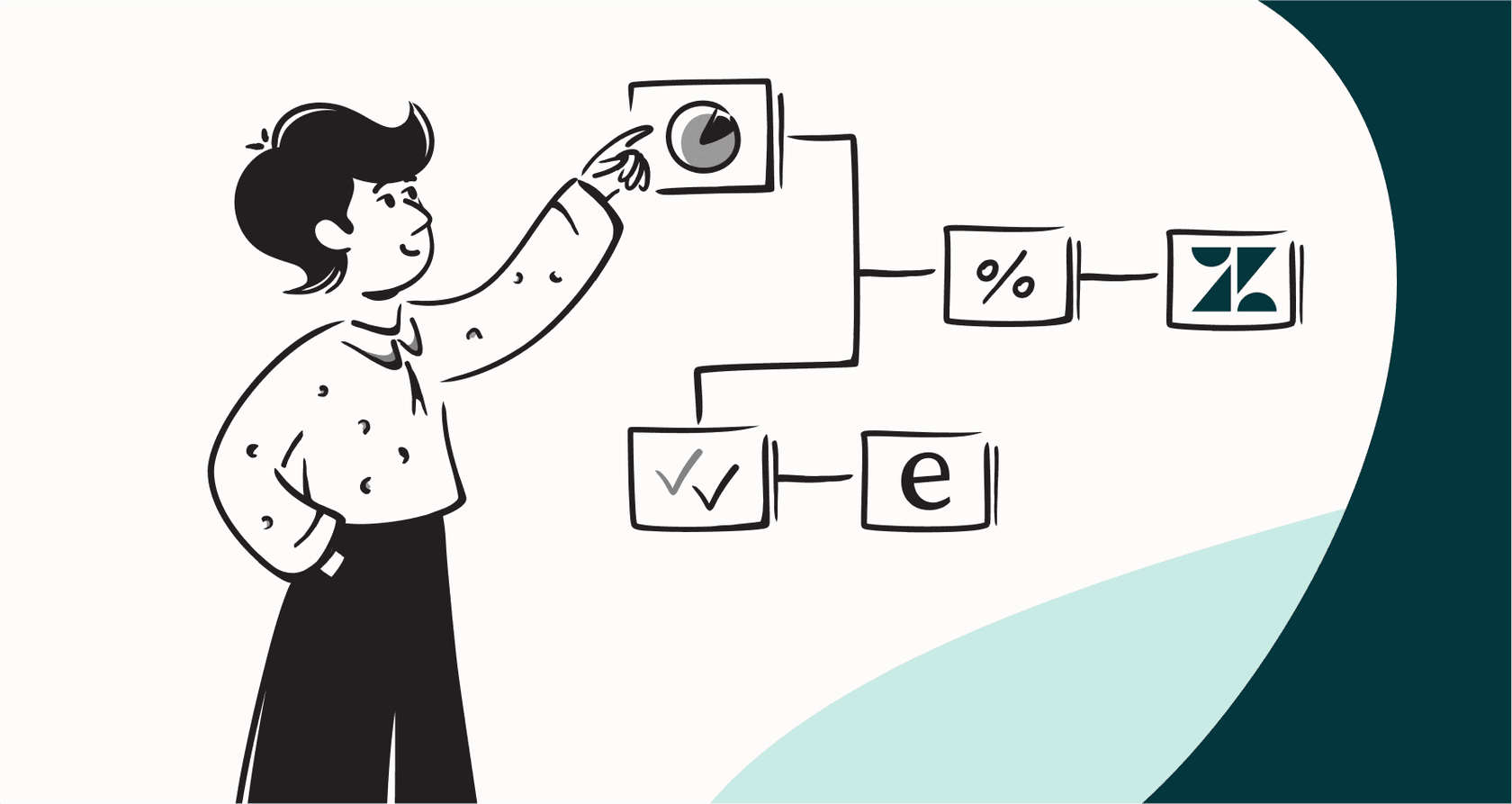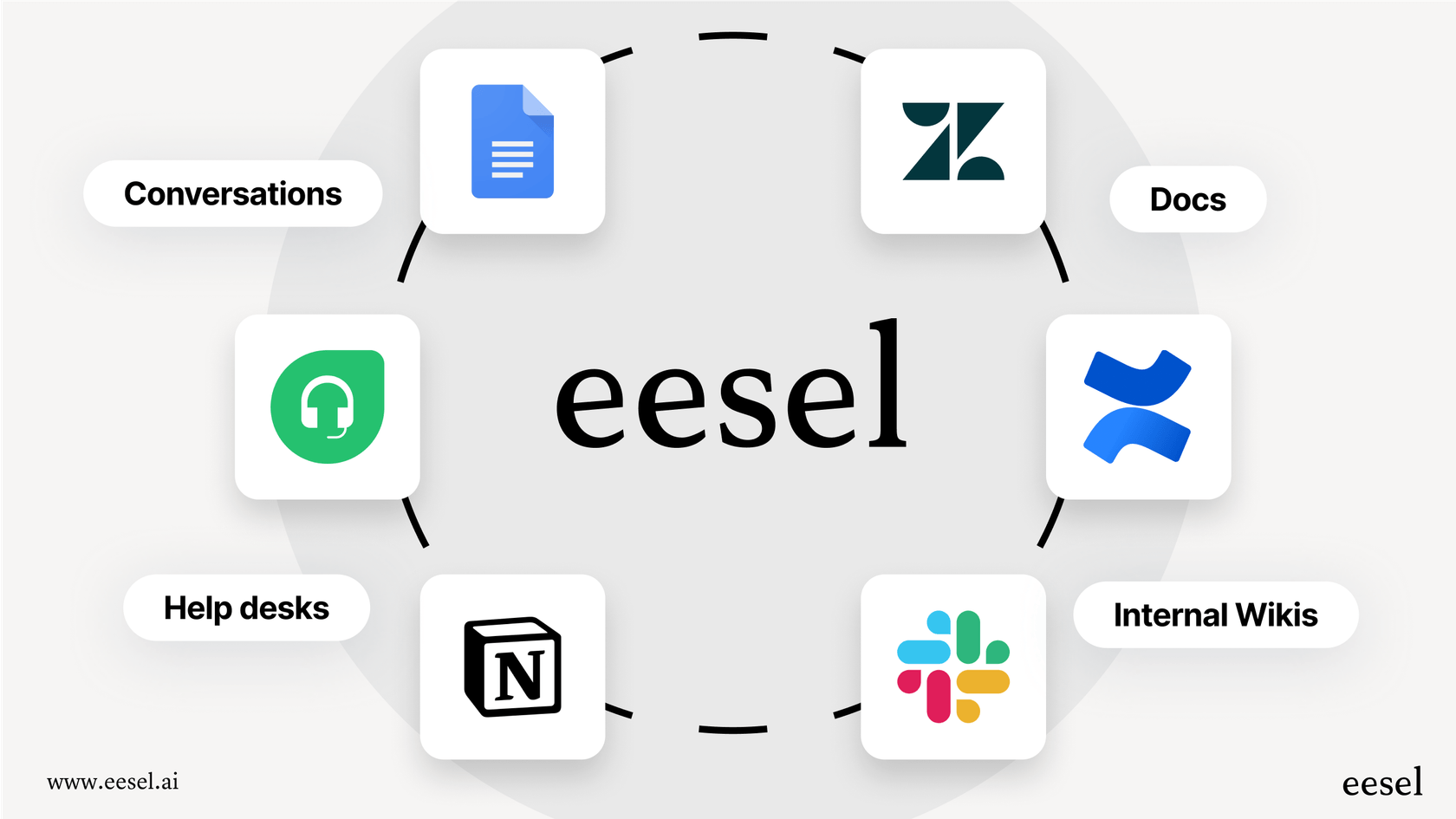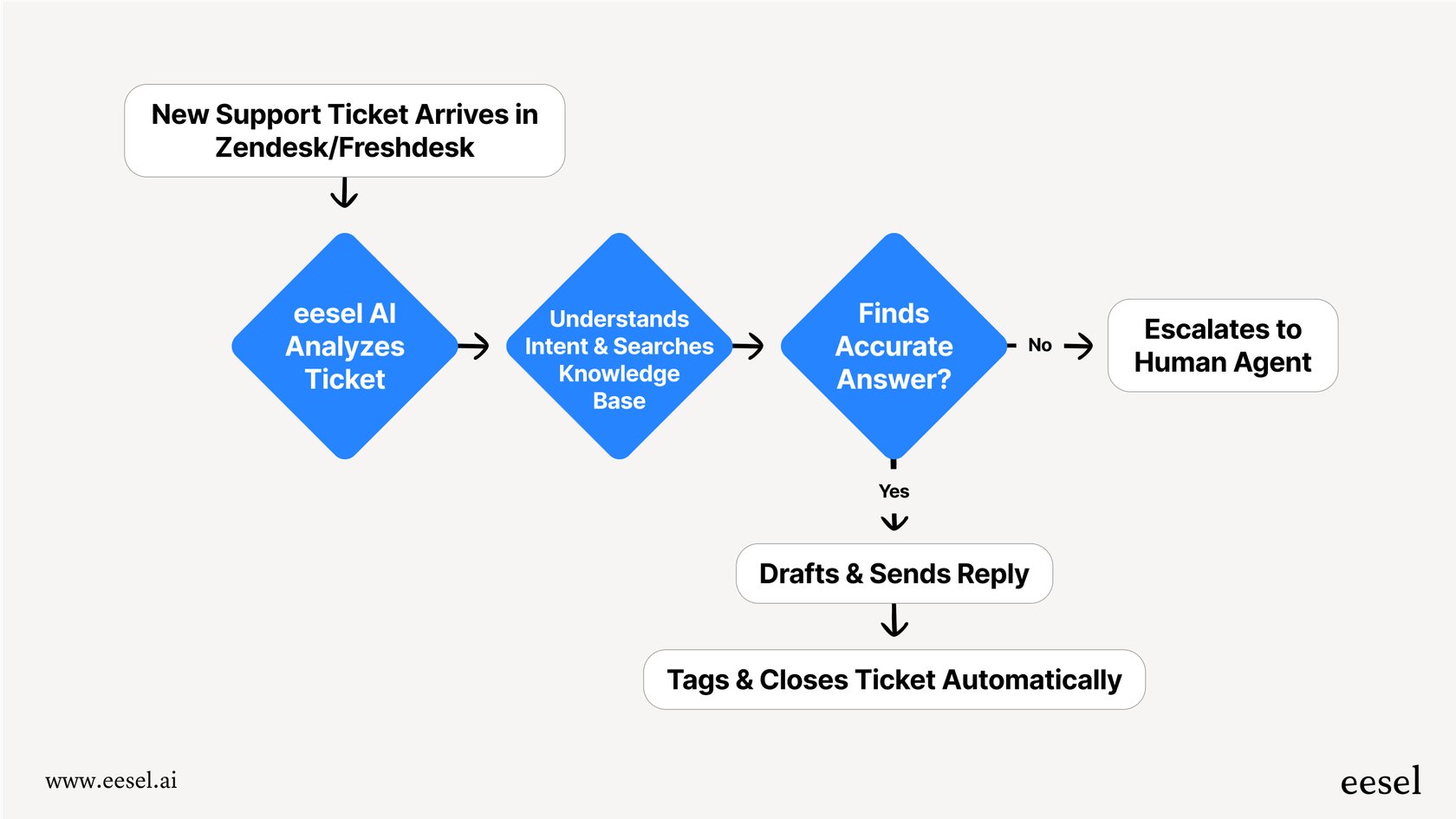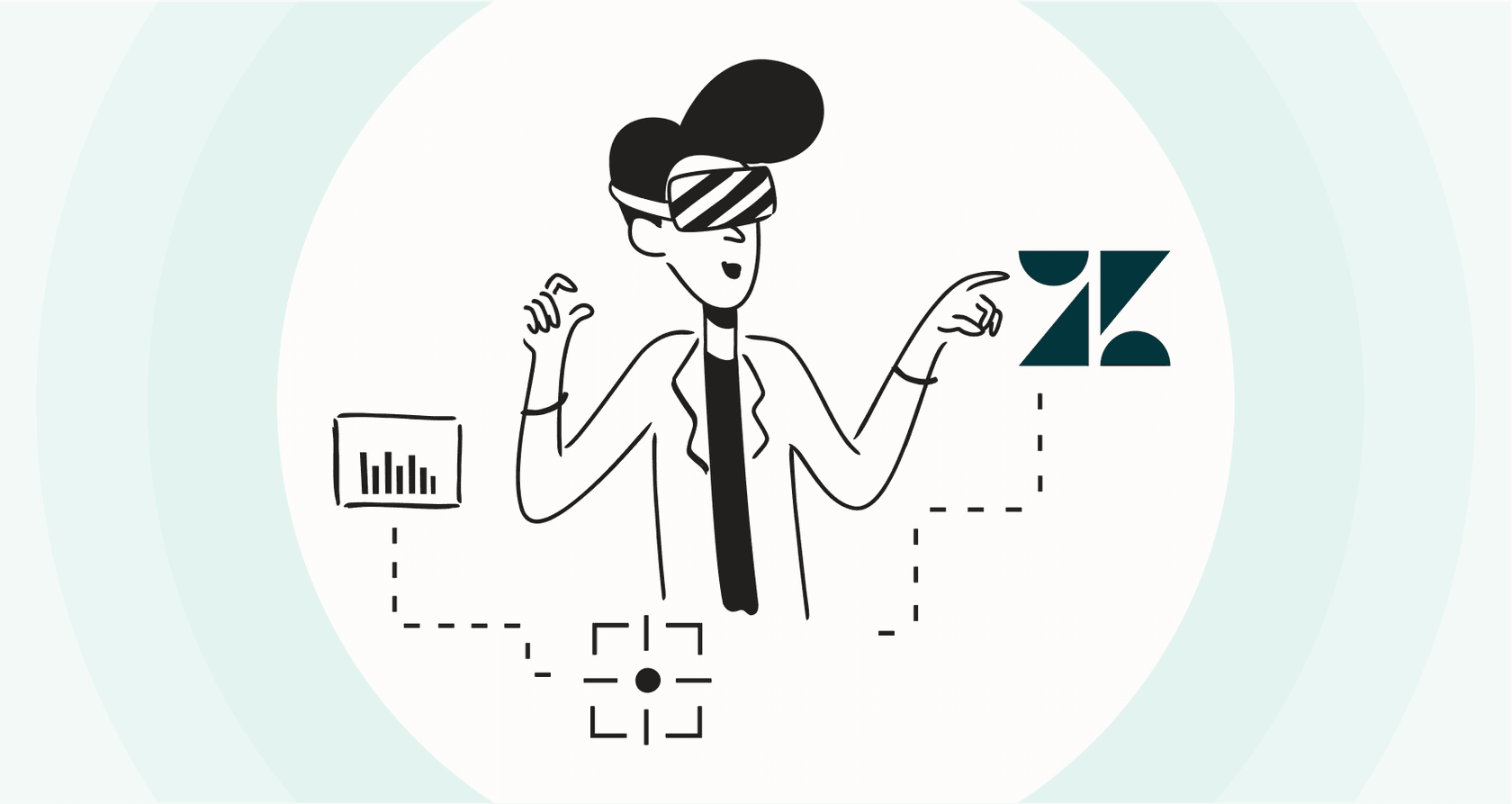Zendesk intelligent triage: A complete setup and automation guide

Kenneth Pangan

Katelin Teen
Last edited October 8, 2025
Expert Verified

Let’s be real: your support team is probably swamped. Ticket volumes keep creeping up, customers expect answers yesterday, and your agents are doing their best to hold it all together. It’s no wonder so many teams are looking to AI for a helping hand. Zendesk’s answer is Intelligent Triage, a native feature meant to bring some order to the chaos of ticket management.
But is it the right tool for your team? This guide will walk you through everything you need to know about Zendesk Intelligent Triage. We’ll cover what it is, how to get it running, what it actually costs, and where it falls short. We’ll also look at a more flexible, powerful way to automate your support without getting boxed into a rigid system.
What is Zendesk Intelligent Triage?
Zendesk Intelligent Triage is an AI feature built right into the Zendesk platform that automatically scans and analyzes incoming support tickets. Think of it as a bouncer for your inbox, trying to make sense of every new customer request before an agent even lays eyes on it.
It’s built to do three main things:
-
Figure out customer intent: Basically, why is the customer writing in? (e.g., "I want a refund," "Where's my order?").
-
Analyze sentiment: Get a read on the customer’s mood (are they happy, neutral, or about to leave a one-star review?).
-
Identify the language: Pretty straightforward, it figures out what language the ticket is in.
The whole point is to streamline your workflow by automatically categorizing, prioritizing, and sending tickets to the right person or department. In a perfect world, this saves your team from the soul-crushing task of manually sorting a cluttered inbox and helps get issues solved faster. It’s the foundation of Zendesk’s native AI, but as we’ll see, that foundation can be a little shaky.
Key features of Zendesk Intelligent Triage
The magic of Intelligent Triage is supposed to be its ability to pull clean, structured data from messy, unstructured customer messages. Let's look at what it actually does.
Intent detection
Intent detection is all about understanding the "what" behind a ticket. The AI reads a customer’s message and tries to pin down their reason for contact, like "password reset," "shipping status," or "billing question." This is the key to automating those common, repetitive questions. Instead of an agent manually tagging a ticket as a refund request, the AI can do it for them, which can then kick off a specific workflow.
Sentiment analysis
Sentiment analysis tries to figure out how a customer is feeling, classifying their tone as positive, neutral, or negative. This is most useful for prioritization. A ticket with a "very negative" sentiment is likely from a customer who is beyond frustrated. By flagging these automatically, you can push them to the front of the queue or escalate them to a senior agent to put out the fire before it spreads.
Language detection
This one is simple enough: the AI identifies the language of the ticket. For any business with a global customer base, this is a huge help. It lets you automatically route tickets to the right multilingual support team. A ticket in German goes to your German-speaking agents, and one in Spanish goes to your Spanish team, all without anyone having to manually reassign it.
How to set up Zendesk Intelligent Triage
Getting started with Intelligent Triage isn't as simple as flipping a switch. You have to meet certain criteria and then manually build out all your automation, a process that can be more involved than you might think.
Eligibility: What you need before you start
Before you can even begin, you have to make sure you check a few boxes. This is often the first hurdle where teams realize it's not a simple plug-and-play solution.
-
Your Zendesk Plan: You have to be on a Zendesk Suite Professional plan or higher. If you're on a lower-tier plan, this feature isn't available.
-
The Advanced AI Add-on: Intelligent Triage isn't included for free. It’s part of the paid Advanced AI add-on, which adds a hefty extra cost for each agent.
-
Enough Ticket Volume: For the AI to work well, it needs data to learn from. Zendesk suggests you have at least 1,000 tickets from the last six months for the model to have a decent chance at accuracy.
-
Your Industry & Language: The AI model is trained for specific industries like eCommerce, software, and travel. If you're in a more niche field, its accuracy might take a hit. Similarly, while it can detect many languages, its more advanced intent and sentiment analysis only works for a handful of them.
Setting up workflows with triggers
Once you’ve confirmed you’re eligible, the setup begins. You can enable the feature in the Admin Center, but the real work is in building business rules using triggers.
The automation isn't truly automatic. You have to manually create specific triggers that fire based on the AI's predictions. For example, you’d have to build a rule that says something like: "If intent is 'Refund Request' AND sentiment is 'Negative', then assign this ticket to 'Tier 2 Support' and set the priority to 'Urgent'."
You have to do this for every single workflow you want to automate. For teams with even moderately complex support needs, this can quickly turn into a tangled web of rules that’s a pain to manage and update.
Monitoring performance with the intelligent triage dashboard
Zendesk gives you a pre-built dashboard in Zendesk Explore to help you see what the AI is up to. It lets you track things like enrichment coverage (the percentage of tickets the AI actually analyzes) and see trends in customer intent and sentiment. This is useful for spotting common problems, but it doesn't reduce the manual work required to build and maintain the automations themselves.
Limitations and costs of Zendesk Intelligent Triage
Alright, let's get to the important stuff. While Zendesk's built-in AI sounds promising, many teams hit some serious roadblocks when it comes to the price tag, accuracy, and overall flexibility.
The hidden costs: Per-agent add-ons and per-resolution fees
Let's talk money. Intelligent Triage isn't part of your standard Zendesk plan. It requires the Advanced AI add-on, which costs an extra $50 per agent, per month. For a small team of 10 agents, that’s an additional $6,000 a year just to get access to the feature.
But what often catches teams by surprise is the per-automated resolution fee of $1.50 to $2.00 each. Every single time your AI successfully resolves a ticket on its own, Zendesk charges you for it. This creates a strange situation where you're effectively penalized for successful automation. The better it works, the higher your bill.
This is a huge difference from a tool like eesel AI, which offers straightforward pricing based on a predictable monthly interaction volume. With eesel AI, there are no per-resolution fees, so you can scale your automation without dreading a surprise on your monthly invoice.
Limited knowledge sources restrict AI accuracy
Here's another big thing to consider: Zendesk's AI mostly learns from articles in your Zendesk Help Center. But be honest, is that where all of your team's knowledge actually lives? Probably not. The real, detailed solutions are often buried in past tickets, internal wikis like Confluence or Notion, and shared Google Docs. If your AI can't tap into that knowledge, it can only answer the most basic, FAQ-style questions, leaving your agents to handle everything else.
eesel AI solves this by connecting all of your knowledge, no matter where it is. It learns from your past tickets, internal docs, and over 100 other tools. This gives the AI the complete picture, allowing it to handle much more complex issues right from the start.
 An infographic illustrating how eesel AI unifies knowledge from multiple sources to improve automation accuracy, a key topic in this Zendesk Intelligent Triage guide.:
An infographic illustrating how eesel AI unifies knowledge from multiple sources to improve automation accuracy, a key topic in this Zendesk Intelligent Triage guide.:Rigid workflows and a lack of risk-free testing
As we mentioned, setting up automation in Zendesk means building manual, rule-based triggers. This system can be incredibly rigid and hard to change as your business evolves.
But the biggest operational risk is the lack of a proper testing environment. There's no good way to test your AI automations on real data before they go live with customers. A single, badly configured trigger could send thousands of wrong answers to your customers, creating a support mess that's bigger than the one you started with.
This is where eesel AI's powerful simulation mode makes all the difference. It lets you test your AI agent on thousands of your historical tickets in a completely safe environment. You can see how it would have responded, check its predicted resolution rates, and fine-tune its performance before a single customer interacts with it.
 A screenshot of eesel AI's simulation mode, which allows for risk-free testing of automation, a feature discussed in this guide on Zendesk Intelligent Triage.:
A screenshot of eesel AI's simulation mode, which allows for risk-free testing of automation, a feature discussed in this guide on Zendesk Intelligent Triage.:Zendesk Advanced AI pricing explained
To make a smart decision, you need the full picture of the total cost. Here’s a simple breakdown of what it costs to get Zendesk's best AI features.
| Plan / Add-On | Cost (Per Agent/Month, Billed Annually) | Key AI Features Included |
|---|---|---|
| Suite Team | $55 | Basic generative replies and article suggestions. |
| Suite Professional | $115 | Everything in Team + more advanced workflows. |
| Advanced AI Add-On | +$50 (on top of Suite plan) | Intelligent Triage, ticket summarization, macro suggestions. |
| Automated Resolutions | $1.50 - $2.00 per resolution | Fee charged each time the AI resolves a ticket without an agent. |
A smarter way to automate: An alternative to Zendesk Intelligent Triage
Relying only on Zendesk's native AI often leads to three big problems: unpredictable costs that punish you for scaling, siloed knowledge that limits accuracy, and risky, inflexible automation that's a headache to manage.
This is why many teams plug eesel AI into their existing setup. It's not a replacement for Zendesk, but a powerful integration that beefs up your help desk without a painful migration. It's designed to give you the enterprise-level AI that Zendesk's native tools are missing.
 A workflow diagram showcasing how eesel AI automates customer support, presented as an alternative in this Zendesk Intelligent Triage guide.:
A workflow diagram showcasing how eesel AI automates customer support, presented as an alternative in this Zendesk Intelligent Triage guide.:By using eesel AI with Zendesk, you get:
-
Go live in minutes: The setup is refreshingly self-serve. You can connect your help desk and knowledge sources and see it working almost instantly.
-
Unify all your knowledge: Connect to past tickets, Confluence, Google Docs, and more to give your AI the context it needs to be genuinely helpful.
-
Test with confidence: Use the simulation mode to test your setup on thousands of past tickets and perfect your automation before you launch.
-
Gain total control: A fully customizable workflow engine gives you fine-grained control over exactly what gets automated and how.
-
Enjoy predictable pricing: With no surprise per-resolution fees, you can scale your support automation without worrying about a runaway bill.
Final thoughts on Zendesk Intelligent Triage
Zendesk Intelligent Triage is a decent first step into ticket automation. It can help categorize and route simple requests, which is definitely better than doing everything manually. But for growing teams that need more power, control, and predictable costs, its limitations become obvious pretty quickly. The hidden fees, dependence on a single knowledge source, and rigid, untestable workflows can hold you back.
For businesses that are serious about intelligent automation, a dedicated AI platform is the logical next step. By integrating a tool designed for flexibility and accuracy, you can turn your Zendesk support from a reactive cost center into a proactive, efficient machine.
Ready to see how a more flexible AI can transform your Zendesk support? Try eesel AI for free and you can be up and running in minutes.
Frequently asked questions
Zendesk Intelligent Triage is an AI feature built into the Zendesk platform that automatically scans and analyzes incoming support tickets. Its core purpose is to streamline workflows by understanding customer intent, sentiment, and language.
The main features include intent detection, which identifies the customer's reason for contact, sentiment analysis to gauge their mood, and language detection for routing tickets. These functions aim to extract structured data from unstructured customer messages.
To be eligible, you need a Zendesk Suite Professional plan or higher, the paid Advanced AI add-on, and a minimum of 1,000 tickets from the last six months for the AI to learn effectively. Industry and language support are also important considerations.
Intelligent Triage requires the Advanced AI add-on, which costs an extra $50 per agent, per month. Additionally, Zendesk charges a per-automated resolution fee of $1.50 to $2.00 for each ticket the AI successfully resolves on its own.
Key limitations include unpredictable per-resolution fees, restricted AI accuracy due to its primary reliance on Zendesk Help Center articles, and rigid, manual trigger-based workflows. There is also a notable lack of robust testing environments for automations.
Yes, the guide suggests eesel AI as a powerful alternative that integrates with Zendesk. It offers predictable pricing, unified knowledge from all sources, a robust simulation mode for testing, and customizable workflow control.
Zendesk provides a pre-built dashboard in Zendesk Explore for monitoring. This allows you to track metrics like enrichment coverage and analyze trends in customer intent and sentiment, helping you understand the AI's performance.





